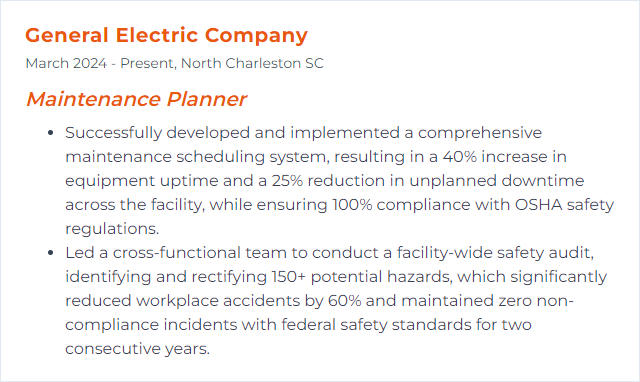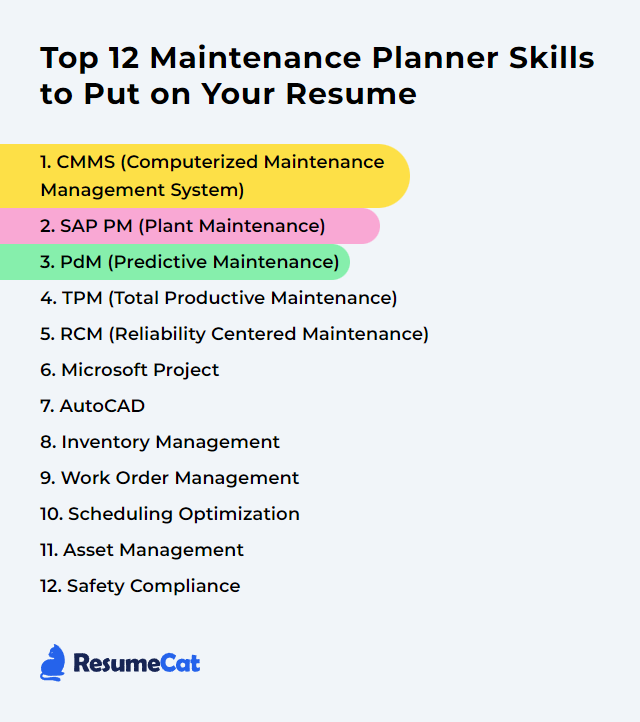Top 12 Maintenance Planner Skills to Put on Your Resume
A well-crafted resume highlighting your maintenance planner skills can set you apart in the job market, demonstrating your ability to ensure operational efficiency and reduce downtime. Possessing a blend of technical knowledge, organizational capabilities, and strategic planning abilities is crucial for anyone looking to excel in this role and catch the eye of potential employers.
Maintenance Planner Skills
- CMMS (Computerized Maintenance Management System)
- SAP PM (Plant Maintenance)
- PdM (Predictive Maintenance)
- TPM (Total Productive Maintenance)
- RCM (Reliability Centered Maintenance)
- Microsoft Project
- AutoCAD
- Inventory Management
- Work Order Management
- Scheduling Optimization
- Asset Management
- Safety Compliance
1. CMMS (Computerized Maintenance Management System)
A Computerized Maintenance Management System (CMMS) is a digital tool that helps maintenance planners schedule, track, and manage maintenance activities and resources, ensuring efficient operation and longer asset life.
Why It's Important
A CMMS streamlines scheduling, tracks maintenance tasks, and organizes asset information. The result: higher efficiency, less downtime, lower maintenance costs.
How to Improve CMMS (Computerized Maintenance Management System) Skills
Push the system to earn its keep. Focus on accuracy, flow, and adoption.
Data integrity: Keep asset records clean and current. Bad data breaks plans and KPIs.
Training: Equip every user with practical, role-based training. Reinforce with quick reference guides and refreshers.
Customization: Build the fields, dashboards, and workflows your team actually needs. Cut clutter; surface what matters.
Integration: Connect CMMS with ERP, inventory, and purchasing to eliminate duplicate entry and enable end-to-end visibility.
Audits and updates: Schedule periodic data audits, archive obsolete assets, and stay on current versions to gain new features and security fixes.
Feedback loop: Capture user pain points, triage them, and iterate. Small tweaks compound.
Preventive maintenance optimization: Use work history and failure data to right-size frequencies and scopes. Trim the noise; protect the critical few.
Done well, CMMS becomes a planning engine—leaner schedules, sharper insights, more uptime.
How to Display CMMS (Computerized Maintenance Management System) Skills on Your Resume
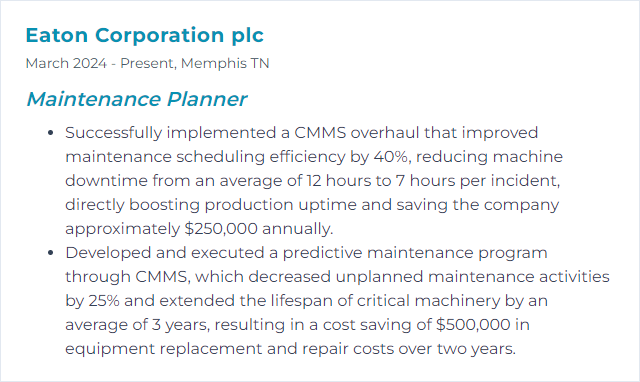
2. SAP PM (Plant Maintenance)
SAP PM is the SAP ERP module for planning, executing, and monitoring maintenance. It supports preventive plans, notifications, work orders, and analysis to keep assets reliable and costs in check.
Why It's Important
It centralizes maintenance data, automates workflows, and links costs, materials, and capacity—so planners schedule smarter and operations run steadier.
How to Improve SAP PM (Plant Maintenance) Skills
Elevate master data: Correct equipment hierarchies, bill of materials, and task lists. Good planning starts here.
Maintenance strategies: Align plans and packages to asset criticality and usage. Avoid one-size-fits-none calendars.
Work centers and capacities: Configure labor and machine capacities to reflect reality. Better capacity equals better promise dates.
Go mobile: Enable field updates for confirmations, time, and parts. Faster feedback, cleaner history.
Continuous training: Reinforce core transactions (notifications, orders, confirmations) and reporting. Share tip sheets and quick wins.
Reporting and KPIs: Track backlog age, schedule compliance, mean time between failures, and plan accuracy. Act on the trends.
Module integration: Tie PM with MM for spares, CO for costs, and PP for production coordination. One data thread, fewer surprises.
Feedback loop: Review planner/technician feedback to refine task lists, durations, and spare parts.
With crisp data and disciplined use, SAP PM turns maintenance from reactive scramble to repeatable system.
How to Display SAP PM (Plant Maintenance) Skills on Your Resume
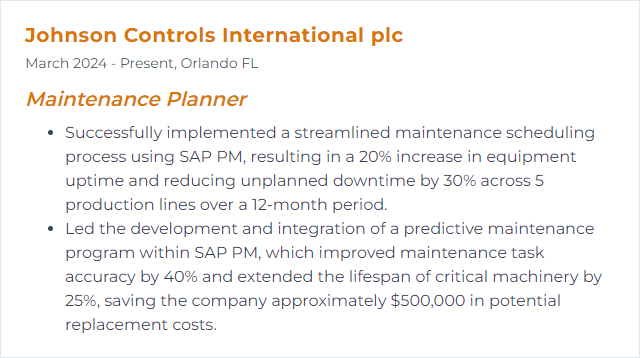
3. PdM (Predictive Maintenance)
Predictive Maintenance uses condition data and analytics to anticipate failures and act at the right moment—neither too early nor too late.
Why It's Important
It slashes unplanned downtime, targets labor where risk is highest, and stretches asset life. Fewer emergencies, calmer schedules.
How to Improve PdM (Predictive Maintenance) Skills
Data quality: Instrument critical assets with reliable sensors; standardize tags and sampling. Garbage in, guesswork out.
Analytics: Apply thresholds, trend analysis, and machine learning where it pays. Start simple; scale if signal beats noise.
Upskill the team: Train planners and techs on vibration, thermography, oil analysis, and diagnosis basics.
Integrate with CMMS: Auto-generate work orders from alerts, with failure codes and recommended actions attached.
Review cadence: Periodically assess models, alarms, and outcomes. Tune for precision and value.
Predict, plan, and pounce—before breakdowns pounce on you.
How to Display PdM (Predictive Maintenance) Skills on Your Resume
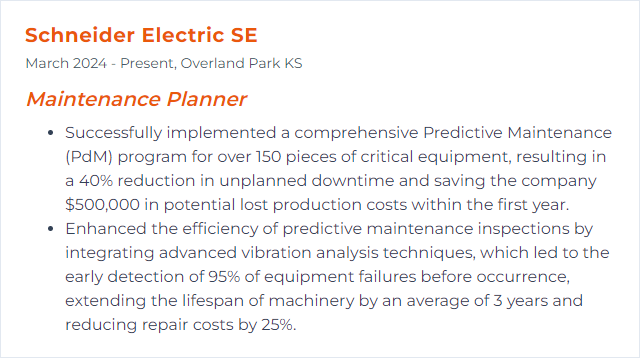
4. TPM (Total Productive Maintenance)
TPM engages everyone—operators, maintainers, leaders—to maximize equipment effectiveness through preventive, predictive, and continuous improvement practices.
Why It's Important
It cuts losses at the source: breakdowns, speed losses, defects, and setup pain. Reliability rises, costs fall.
How to Improve TPM (Total Productive Maintenance) Skills
Structured plans: Build layered maintenance—operator care, preventive tasks, and condition-based checks—grounded in actual failure modes.
Operator involvement: Train for basic care (clean, inspect, tighten) and early abnormality detection. Ownership changes behavior.
Data-driven focus: Track OEE and the six big losses; attack the largest constraints first.
Skills and standards: Create clear work standards, quick-change guides, and focused training to lock in gains.
Root cause analysis: Use 5-Whys, fishbone, and fault-tree methods to eliminate repeat offenders.
Continuous improvement: Run small, fast PDCA cycles. Celebrate fixes, then standardize.
TPM thrives on habits. Build them, and uptime follows.
How to Display TPM (Total Productive Maintenance) Skills on Your Resume
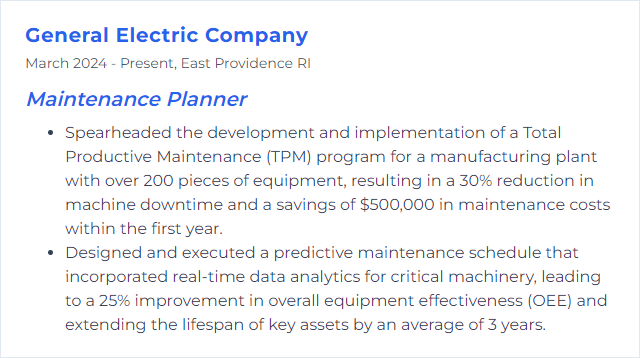
5. RCM (Reliability Centered Maintenance)
RCM tailors maintenance to how each asset fails and what those failures cost, ensuring the right task at the right interval for the right reason.
Why It's Important
It prioritizes resources by risk and consequence, tightening focus on critical equipment while avoiding busywork on non-critical items.
How to Improve RCM (Reliability Centered Maintenance) Skills
Define functions and contexts: Clarify what the asset must do, under what conditions, and to what performance standard.
Analyze failure modes: Conduct FMEA to expose how components fail, why it matters, and how you’ll detect it.
Prioritize: Rank by safety, environment, production, and cost impacts. Let criticality steer the plan.
Select strategies: Choose predictive, preventive, run-to-failure, or redesign based on failure characteristics and economics.
Implement and monitor: Track KPIs like MTBF, MTTR, schedule compliance, and defect elimination rate.
Iterate: Update the program when data contradicts assumptions. Living documents beat dusty binders.
RCM gives planners a rational playbook—no more guesswork.
How to Display RCM (Reliability Centered Maintenance) Skills on Your Resume
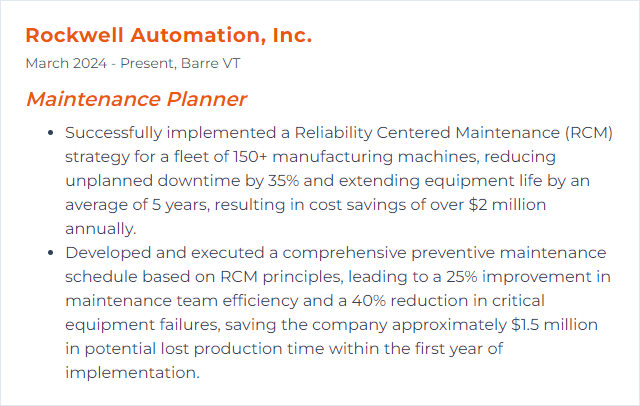
6. Microsoft Project
Microsoft Project helps planners schedule work, assign resources, visualize dependencies, and track progress from plan to closeout.
Why It's Important
It clarifies timelines, exposes critical paths, and coordinates labor and materials—so maintenance windows hit their marks.
How to Improve Microsoft Project Skills
Tailored views: Build views that spotlight constraints, critical tasks, and upcoming shutdown work.
Integrations: Connect with CMMS, timekeeping, and procurement via imports or automation for live updates.
Templates: Standardize repeatable outages and PM campaigns with ready-to-run templates.
Reporting: Customize dashboards for schedule variance, resource loading, and percent complete.
Set it up once, then let it keep the plan honest.
How to Display Microsoft Project Skills on Your Resume
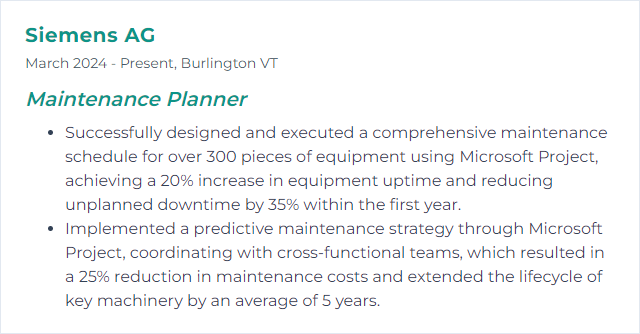
7. AutoCAD
AutoCAD creates precise 2D and 3D drawings for layouts, clearances, and parts—useful for planning access, safety, and maintainability.
Why It's Important
Accurate drawings prevent surprises in the field. Better fit, fewer clashes, safer work.
How to Improve AutoCAD Skills
Custom tool palettes: Collect your most-used blocks, symbols, and commands to speed repetitive work.
Data extraction: Pull parts lists and attributes straight from drawings to support spares and job kitting.
Layer discipline: Use consistent naming and colors to isolate systems quickly.
Dynamic blocks: Build adjustable components for common equipment and clearances.
Automation: Script recurring tasks and batch standards updates.
Ongoing learning: Keep up with new features and shortcuts; small efficiencies compound.
Good CAD makes maintenance plans visible, testable, and persuasive.
How to Display AutoCAD Skills on Your Resume
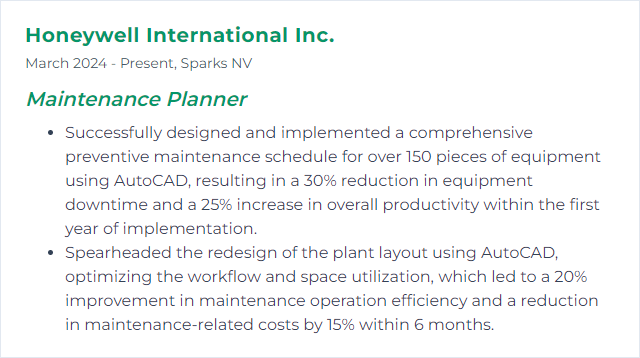
8. Inventory Management
Inventory Management means controlling the parts and materials that keep maintenance moving—ordered, stored, issued, and replenished without drama.
Why It's Important
Right part, right time. Less downtime, fewer premium freight charges, cleaner audits.
How to Improve Inventory Management Skills
Systemize: Use an inventory or CMMS module for real-time stock, min/max, and reservations.
Count routinely: Cycle counts and spot checks beat annual shocks. Fix variances fast.
Lean levels: Apply just-in-time where risk is low, and carry safety stock for true critical spares.
Forecast with history: Use consumption and lead times to set reorder points that actually work.
Supplier depth: Qualify alternates, agree on lead times, and measure performance.
ABC analysis: Focus controls on A-items, streamline C-items, and review Bs quarterly.
Kitting: Pre-stage parts for planned jobs to reduce delays and errors.
Automation: Turn on automatic reorders with sensible safety stocks and review gates.
Train and standardize: Clear receiving, issuing, and return-to-stock procedures keep data honest.
Continuously refine: Revisit settings when demand or lead times change. Adapt quickly.
Healthy storerooms make schedules stick.
How to Display Inventory Management Skills on Your Resume

9. Work Order Management
Work Order Management covers the lifecycle of maintenance tasks—request, plan, schedule, execute, close, and learn.
Why It's Important
It aligns priorities, assigns resources, tracks progress, and preserves history. Reliability loves order.
How to Improve Work Order Management Skills
Clear scope: Define the problem, location, priority, and success criteria up front.
CMMS-driven flow: Create, plan, and close work in the system—checklists, photos, time, and parts included.
Standard jobs: Reuse job plans for recurring work with estimated hours and materials.
Training: Teach planners and technicians consistent coding (failure, cause, remedy) to strengthen analytics.
Measure and adjust: Watch backlog health, response time, and schedule compliance. Tackle bottlenecks.
Communication: Sync with production on windows and constraints. No surprises on either side.
Mobile updates: Capture work details in the field for real-time status and accurate histories.
Preventive bias: Shift volume from break-in work to planned PM and condition-based tasks.
Tight work orders make better weeks—and fewer weekend callouts.
How to Display Work Order Management Skills on Your Resume
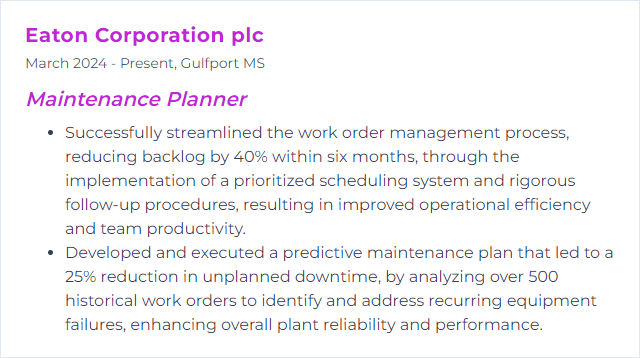
10. Scheduling Optimization
Scheduling optimization assigns the right people, parts, and time windows to the right work, minimizing downtime and churn.
Why It's Important
It boosts wrench time, protects critical assets, and keeps promises to operations—more value from the same crew.
How to Improve Scheduling Optimization Skills
Use history: Estimate durations from actuals, not hunches. Update as you learn.
Prioritize ruthlessly: Rank by safety, compliance, production risk, and cost. Let the list speak.
Balance resources: Match skills, certifications, and tool availability to job needs.
Leverage CMMS/EAM: Automate schedules, apply dependencies, and protect maintenance windows.
Continuous feedback: Review weekly slippage and causes. Remove repeat blockers.
Real-time signals: Fold in PdM alerts and IoT data to preempt failures and re-sequence work.
Engage the crew: Tech input on sequence and durations makes the plan stickier.
Schedule with intent, then keep tightening the loop.
How to Display Scheduling Optimization Skills on Your Resume
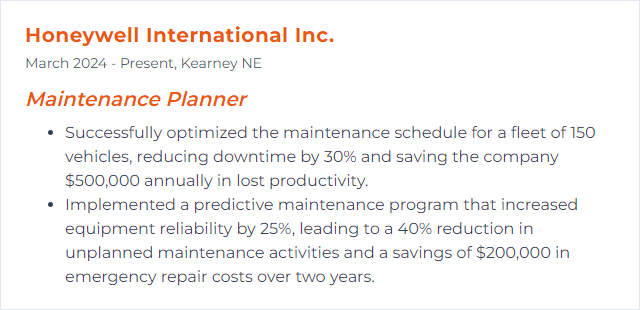
11. Asset Management
Asset Management coordinates the full lifecycle of physical assets—plan, acquire, operate, maintain, and retire—to meet organizational goals. It balances performance, risk, and cost, often guided by standards like ISO 55001.
Why It's Important
Done well, it raises reliability, reduces lifecycle cost, and aligns maintenance with strategy.
How to Improve Asset Management Skills
CMMS/EAM foundation: Centralize asset registers, criticality, and lifecycle histories. Trusty data, better decisions.
Predictive approaches: Add condition monitoring where it pays; intervene just-in-time.
Spares discipline: Balance availability and carrying cost with criticality-based stocking.
People and skills: Invest in reliability and planning training; certify where it helps.
RCM mindset: Align tasks with failure modes and consequences. Avoid ritual maintenance.
Asset management is strategy in work boots.
How to Display Asset Management Skills on Your Resume
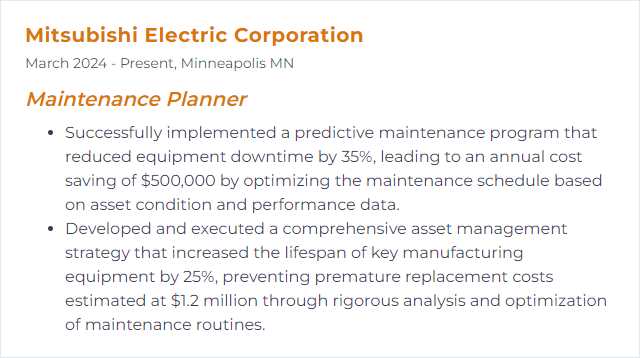
12. Safety Compliance
Safety compliance ensures maintenance activities meet applicable regulations, standards, and site policies—preventing harm and protecting operations.
Why It's Important
It safeguards people, preserves equipment, and keeps the organization on the right side of the law.
How to Improve Safety Compliance Skills
Stay current: Track regulatory updates and industry standards relevant to your site and processes.
Risk assessments: Perform job hazard analyses and permit-to-work reviews before the first wrench turns.
Training and awareness: Provide role-specific training and refreshers; reinforce with toolbox talks.
PPE and equipment: Specify, maintain, and verify the right protective gear and safety devices.
Procedures and documentation: Keep lockout/tagout, confined space, hot work, and electrical safety procedures clear and current.
Reporting culture: Make it easy to report near misses and hazards; act visibly on feedback.
Emergency readiness: Drill responses for fires, spills, and medical events. Muscle memory saves seconds.
Digital tracking: Use compliance checklists, audits, and corrective action logs to close gaps fast.
Safe work isn’t paperwork—it’s habits, reinforced daily.
How to Display Safety Compliance Skills on Your Resume
